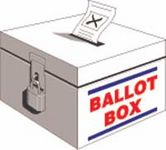Electronic Voting
Contents
Group Name
Group Name
Group Members
Erika Angyalfi, Samantha Evans, Ashley Kosasih, Lindsey Rizalla, Petra Vadelova
Initial Project Statement
With all the technology being introduced into the world, why is that we still cant get a simple voting machine right???
Argument
History of Electronic Voting
Voting has come a long way through the years. Our generation has experienced massive leaps in technology in a very short time frame and this includes changes to the way people vote.
Voting began as a the very simple act of raising your hand when your choice was said. It wasn't until 1856 that the state of Victoria in Australia clued in to create the " Australian Secret Ballot" and used uniform official ballots.
 The next voting technology to make an impact was the lever machine. This cutting edge technology was invented in 1892.
The next voting technology to make an impact was the lever machine. This cutting edge technology was invented in 1892.
How It Works
Imagine not having to get out of your bed to vote for the next upcoming election, be it federal, provincial, or local. Now with electronic voting, you could do it right from your very own personal computer. This new form of technology is commonly called "E-voting" and refers to both the electronic means of casting your vote for your preferred candidate, and also the means in which the votes are tabulated. By this particular definition, many already existing forms of voting already qualify as "E-voting." These include punch cards and optical scan cards. The results of these types of voting processes are tabulated electronically and have been used for decades.
There are two main types of electronic voting being introduced into society. Direct Recording Electronic (DRE) Systems, and Voting on the Internet (VOI). Both of these systems are subject to criticism from the public, but with the continually growing population of those who are able to vote, just think about all those ballots that would be have to be coordinated by hand and manually counted. Before "E-voting" people would have to go to their local polling facility during the set hours. Volunteers would then make sure that you were indeed a registered voter, then you'd go to a little booth and cast your ballot. Once closed, election officials would take the ballots to a centralized tabulation site where they would count and report the results. A very long and frustrating process. This process, the paper-based system, is currently the most common used form of voting, but it still possesses an electronic component.
Paper-based Systems
With a paper-based system, the electronic compnent is usually a tabulation device. This means that the results from elections are counted and reported with the help of an electronic system. This is a great deal faster than counting all the ballots manually. Voters use a touch screen, or a similar device, to make their choice. Then a printer, which was attached to the device, prints out a ballot. The officials then take all the ballots to a centralized location where seperate electronic devices optically scans and tabulates the results.
Direct Recording Electronic (DRE) Systems
DRE systems are essentially computers. Voters view ballots on a screen and make choices using an input device such as a bank of buttons or a touch screen. Some DRE systems also employ a card swipe system that must be activated before the casting of the ballot. The votes cast are then stored on memory cards, CDs, or other memory devices. Once closed, the officials transport the memory devices from each machine to centralized locations for tabulations, much like they would with paper-based systems. Some DRE machines also have the ability to broadcast results over a modem-to-modem line. However, due to concerns with data security, these votes arent always counted as being official until verified by tabulating the results which are stored on the memory devices. Many of these DRE systems can also print a paper record of ballots cast for furter verification.
Voting over the Internet (VOI)
This experiment was first piloted by the Federal Voting Assistance Program (FVAP) in 2000 to see if election votes could be reliably and securely cast over the internet. Upon the adoption of this system by the FVAP, it was the first time in the United States of America that ballots cast over the internet were counted as legitimate in federal, state, and local elections. This system was designed to cast votes, not to tabulate them. Volunteers recieved a CD that had a browser plug-in which displayed and transmitted ballots to the FVAP servers. The Department of Defense (D0D) included a digital certification program which made sure that each and every voter was authentic and registered. Once a ballot was submitted, the DOD would then deactivate the voter's certification so that they were not permitted to cast more than one ballot for the election. The server to which the ballots were transmitted was in a secure location with very limited access and an uninterrupted power supply. There were also two intrusion detection systems which were installed for the purpose of monitoring any attempts of fraudulent activity.
Advantages/Disadvantages
The three previously discussed systems for electronic voting all have their advantages and disadvantages. Let's discuss these in greater detail.
Paper-based Systems
Advantages- the paper-based systems have a few very crucial advantages which allow for the pubic to be quite comfortable with this type of system. These advantages include:
- The ballot is represented by a piece of paper. This reassures voters that their votes are being counted.
- Everything is manually counted and verified so that there are no mistakes made in the final results.
- This system has been used for a very long time which means that it is trusted by the public.
Psycology of "E-voting"
erika has this one
Statistical Data
-graphs -charts
Controversies Related to Electronic Voting
Conclusion